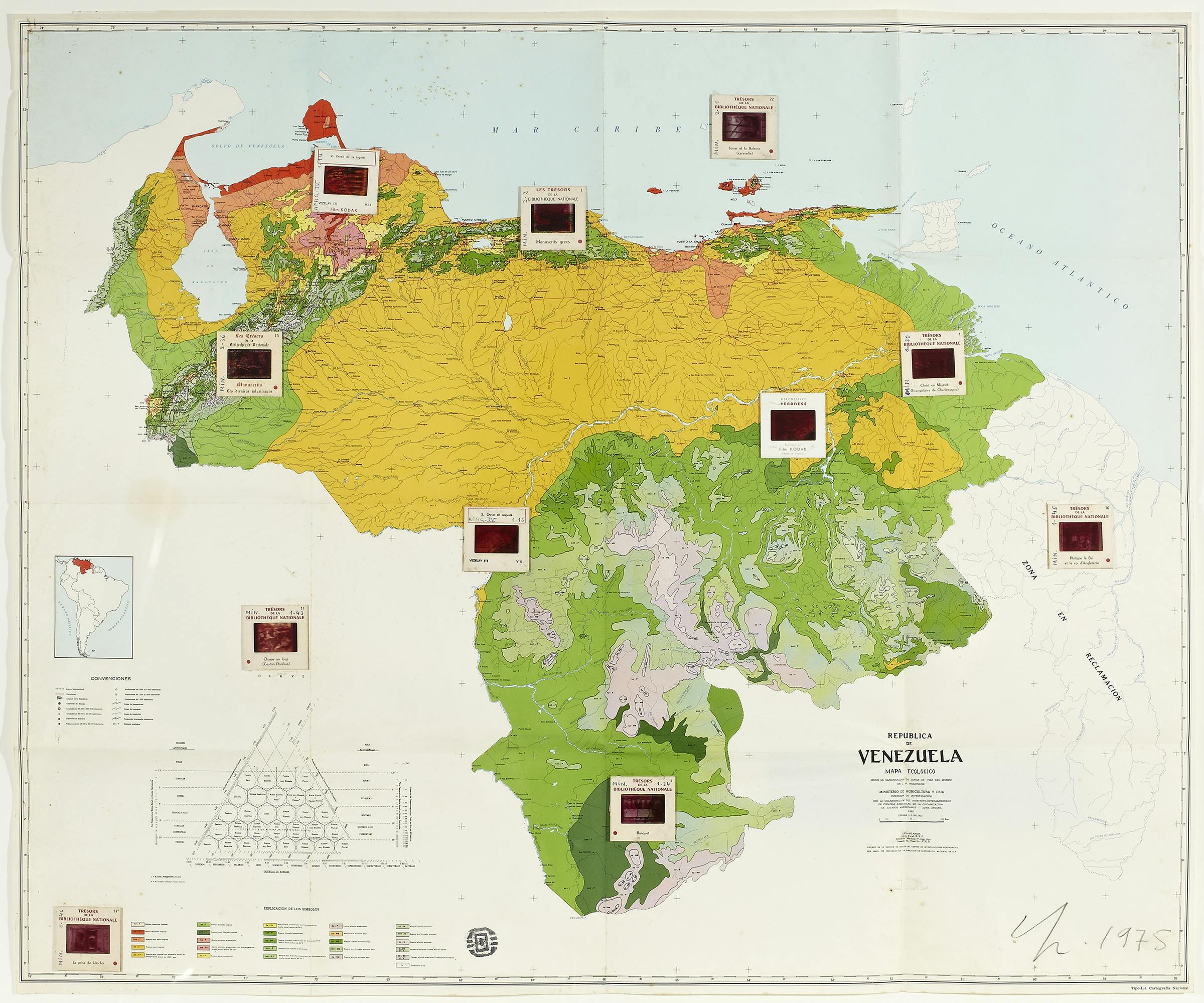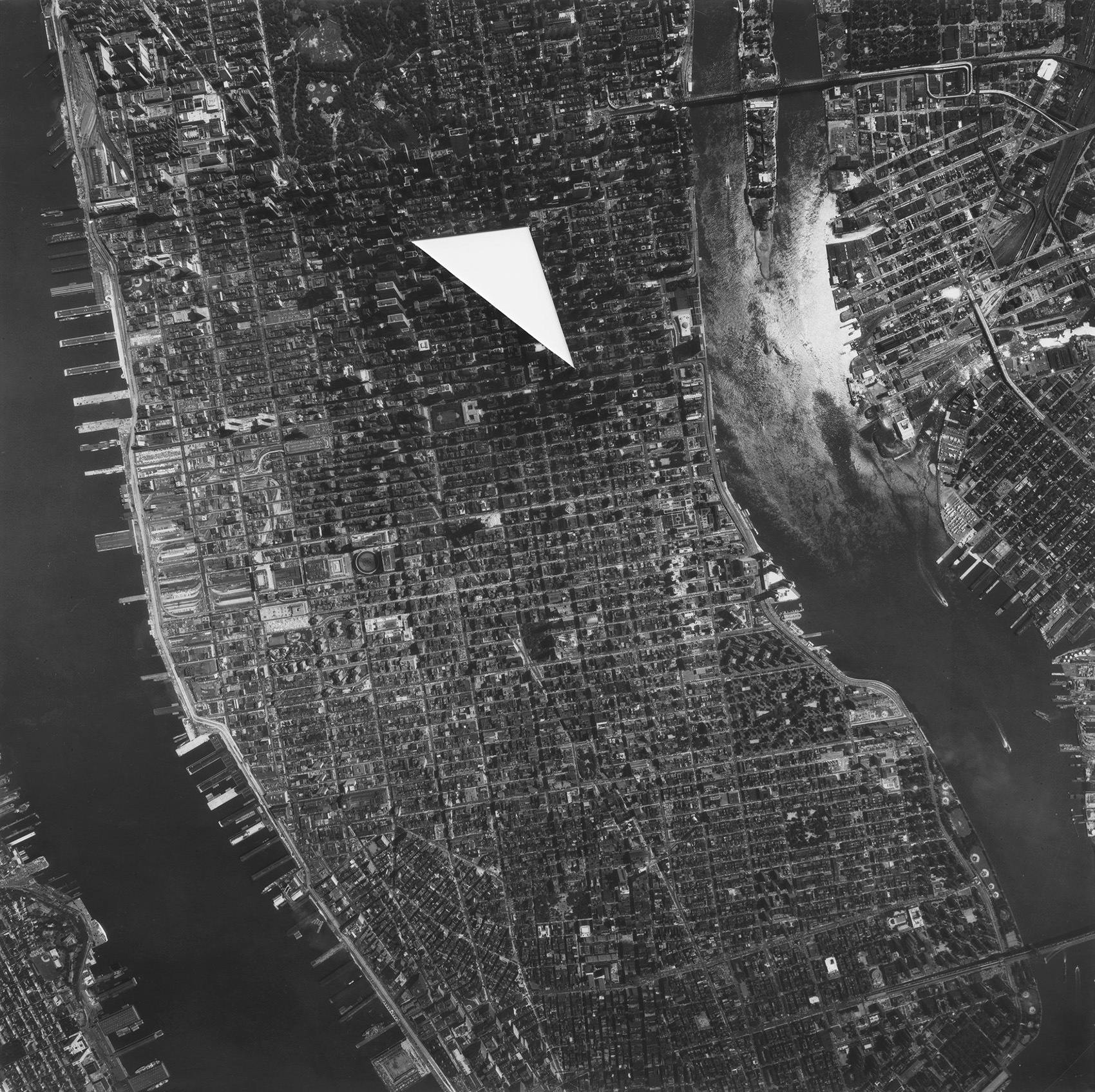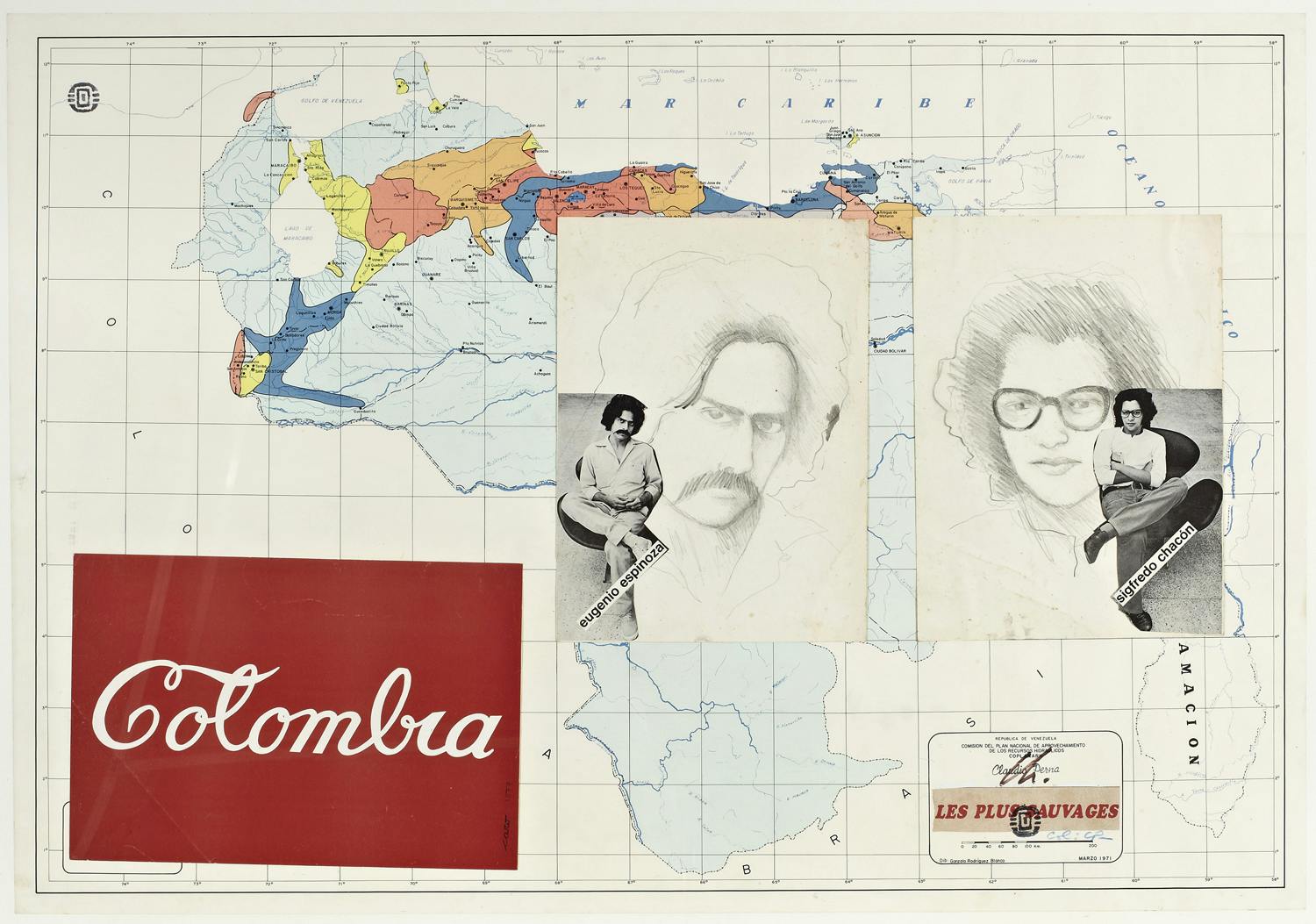
Claudio Perna, República de Venezuela - Mapa ecológico, 1975
Re: Collection invites a range of historians, curators, and artists to respond to the artworks in our collection through approachable texts.
Translation by Jacob Steinberg
Claudio Perna (1938–1997) and Sol LeWitt (1928–2007) are both known for their use of maps, cartography, aerial photography, and satellite images from different geographic coordinates as interventional supports in their work. We could fall into the temptation of drawing a comparison between their works, based on their similarities and overlooking their—explicit and significant—differences. Based on the strength of the facts, doing such would imply falling into the temptation of assimilating Perna’s work into the canonical practices of Anglo-Saxon Conceptualism that LeWitt so brilliantly embodies. Yet everything indicates that, unlike LeWitt’s systematic approach (he was perhaps one of the most systematic artists of the 20th century), Perna’s work tends to constitute itself as an unsystematizable chaos, adhering to a more impulse-driven approach to art rather than an intellectual one, perhaps closer than LeWitt ever got to embodying his own definition of the artist: Conceptual artists are mystics rather than rationalists. 1
Perna’s work, as well as his decision to participate in cartography, thus indicate an unarchiving, declassifying, and often rhyparographic drive. 2 Nonetheless, the effect of both artists’ participation in cartography is the inactivation of the cartographic operation, the deactivation of the map as a practical instrument for orientation. Faced with Perna’s maps, as with LeWitt’s maps and photographs, we could say: this is not a map (anymore).
What, then, are these works? It’s a critical question to ask, particularly in light of the following: Sol LeWitt was an artist, like Perna, but in addition to being an artist, and unlike LeWitt, Perna was also a professional geographer, a tenured titular professor of the Geography Chair at the Central University of Venezuela, to which he dedicated a great part of his life and where he often found visual inspiration for his work. Perna’s interventions in maps generally differ from LeWitt’s photographs and maps in that they are not fragments or clippings; Perna works, with few exceptions, on complete maps, defined canonically, and his intervention translates, without fail, into elements added as a collage, or into inscriptions, that is, a system of autographic supplements.

Sol LeWitt, R847 - A Map of Florence Without a Rectangle, 1972
In the case of Sol LeWitt, with quite few exceptions, the intervening supports are fragments of maps or clippings of aerial photographs: the cartography—the view of a city—has been altered in advance. Furthermore, LeWitt intervenes primarily by extracting segments: doubly amputating, in other words, by way of the inscription of a void with the already-fragmented cartographic material as a base.
One can imagine how the operation LeWitt’s cartographic interventions calls us toward implies the impossible imaginary reconstruction of extracted fragments: the conversion of the map into an idea. But it would be a “sublime” idea, that is, strictly speaking, unimaginable.
In contrast, the supplements Perna uses to intervene in his maps—chaotic or poetic—seem to unleash unexpected associations, symbolic redundancies, iconic keys that add an overabundant dimension to the image the map summons, through a system of accumulation that is simultaneously graphic and iconographic.
These two operations could be linked to a difference in painting and sculpture of clearly humanistic origin noted since antiquity. It is what Michelangelo declared in a well-known letter to Benedetto Varchi, in which he defines, by his own judgment, the two paths of material production of these arts: “Lo entendo scultura quella che si fa per forza di levare; quella che si fa per via di porre é simile alla pittura.”(I understand sculpture to be made by the action of taking away, while painting is made by the action of adding.”) 3
Painting, per the humanist artist’s consideration, functions by adding more material to material whereas sculpture—understood as carving away—is the result of the extraction of material from material. One may deduce the distinction he sought, despite his manifest intention of “abandoning such a dispute” between those Renaissance arts (and artists), affirming the spiritual superiority of an art that does not add material to the world, of one that leaves the material lighter, so to speak, and reveals, through extraction, the idea within it.
Sol LeWitt’s maps correspond to the via di levare (the action of taking away); Perna’s, to the via di porre (the action of adding).
While evoking these concepts may be anachronistic, it remains theoretically relevant.

Sol LeWitt, A Photo of Central Manhattan With the Area Between the Seagram's Building, the Chrysler Building, and the CBS Building Cut Out, 1978
There was no more corrosive attempt to dismantle the foundations of modern art in the late 1960s than that undertaken by Douglas Huebler, laconically, through his contribution to a historical exhibition organized by Seth Siegelaub: “The world is full of objects, more or less interesting; I do not wish to add any more. I prefer simply to state the existence of things in terms of time and/or place.” 4 With this declaration, in addition to establishing a radical poetics against any alternative to the via di porre, Huebler affirmed his work was beyond the direct experience of perception and, as such, could only manifest as a document.
What he appears to have overlooked is that by adding papers to a world already full of them, Conceptual art could never deliver on its promise as an administrator. It never stopped placing more objects among objects, albeit subtle or light ones, and also could never produce an art whose (material) execution was in reality absolutely “perfunctory” (in the words of Sol LeWitt). 5
But there’s more. In its dream-like “accountant's program,” in its resolve to substitute the world with data, and verbal description, or immense enumeration, the art of the idea—Conceptual art—brought about, surreptitiously, perhaps without even realizing it, a subtle return to a humanistic ideology that had regulated the practice of the arts since the Renaissance until the dawn of the modern era in accordance with a principle of equivalence between images and words, the ut pictura poesis that humanism salvaged from Horace and Simonides. Robert Klein described the end of that ideology that affirmed the primacy of the idea over form, the categorical antecedence of the object of discourse over its enunciation when, by imposing the privilege of the maniera in art—that is, the primacy of the execution—there also emerged an aesthetic of fascination, outlined by Giordano Bruno around 1600 in his Of Bonds in General. 6 It is this modern aesthetic, this rupture of the ekphratic dogma (the imperative of the ideal proportion between reality and the word) that, half a millennium later, tried in vain to dismantle Conceptual art and its enunciative and documental skirmishes. But with it, antithetically, as with any survival, as with any Nachleben, the art of the idea and the practitioners of Conceptualism inadvertently never stopped—at least in the closed, Anglo-Saxon sphere—bringing the practice of art back to the home-prison of language, with its blind faith in the sayable, with its literal filigrees toward the power of propositions, with its respect for the undoubtable strength of numbers.

Claudio Perna, Les Plus Sauvages - Colombia, 1977–78
I’ve always suspected there was another art of the idea, parallel and corrosive, much more ambiguous and seductive than the art of tautology or factual equations; a Conceptual art attentive to the unnamable, uncontrollable, random, and undetermined material of language in its enumeration of reality and life. This art, which developed in the margins of the powerful Western institution of art—that is, in the Global South and the East of Europe—is not an art of linguistic certainties nor does it profess blind faith that everything can be said or enumerated. To the contrary, it is a constellation of doubts before a language wherein shine ellipses; great syncopes; impassive, mute silences; redundancies; confusions; digressing homonyms; the stuttering voice; the enunciation of fictions; abrupt, chaotic, guttural eruptions; animals that breath, too, in the heart of language. I believe Claudio Perna’s work comes from these roots, that behind each of his statements on art as idea lay, barely hidden, a mocking grimace, a guffaw, an explicit body, an abundance, an excess, a hiccup. His maps—full of additions, transformed into a foundation for portraits, illegible superpositions, and affective inscriptions—are identified with a kind of art whose ambition is not to leave more space in the world nor mark openings or voids in it or substitute the world for cold data, but rather boundless, unclassifiable plenitudes, absolute singularities in which the artist can draw, unprogrammatically, an incessant search for social (s)cul(p)ture such that from the geographer may emerge, albeit fragmented, the expression of a geography beyond documentation, beyond data and cartography: the unending figure of an emotional geography.